Of all the famous Greek antiquity spots, the Acropolis of Athens is definitely the most legendary one. It’s not an exaggeration to say that a visit to Greece isn’t complete without a visit to the Acropolis Hill. Apart from seeing the Parthenon and several other ancient monuments, you will also enjoy a spectacular view of Athens.
Although I have several photos from the Acropolis of Athens (which I plan to share in a future post), I never shot Polaroids there. Therefore, a couple of weeks ago, I decided to visit Parthenon and take the SX-70 with me. It was a hot day in May, and the sun was shining. I was curious to see how the SX-70 handles the intense light and if I could get some usable images.
As we all know, Polaroid cameras are mainly used for close-ups and less for landscape photos. But I was ultimately satisfied with the results. The SX-70 performed exceptionally well, and the details it captured amazed me.
What you’ll see in the Polaroid Diaries: A Day at the Acropolis of Athens
I had two SX-70 films with me, but I didn’t shoot all 16 photos. As I often write on this blog, polaroids make us thoughtful. There are plenty of things to consider when it comes to instant photography, mainly because nothing can guarantee a fine result.
So, in this Polaroid Diaries edition, you will see several photos of the Acropolis of Athens and historical monuments like the Parthenon, the Erectheum, and the Propylaea. Moreover, to give you a better impression, I’ll add a couple of shots from the area around the Acropolis of Athens.
That said, in the Polaroid Diaries: A Day at the Acropolis of Athens, you will see a total of 10 photos. Most of them are taken straight at the Acropolis and around the Parthenon. Straight above, you can also watch a 4K video from the Acropolis that I shot while walking around.
Polaroid Diaries: A Day at the Acropolis of Athens (SX-70)
The first thing you’ll see when approaching the Acropolis of Athens is the Propylaea. The Propylaea is actually the impressive gateway leading to the main site. Constructed mainly of white Pentelic marble and grey Eleusinian marble, it was the work of Athenian architect Mnesicles. Its construction started approximately in 437 BC and went on for a couple of years.
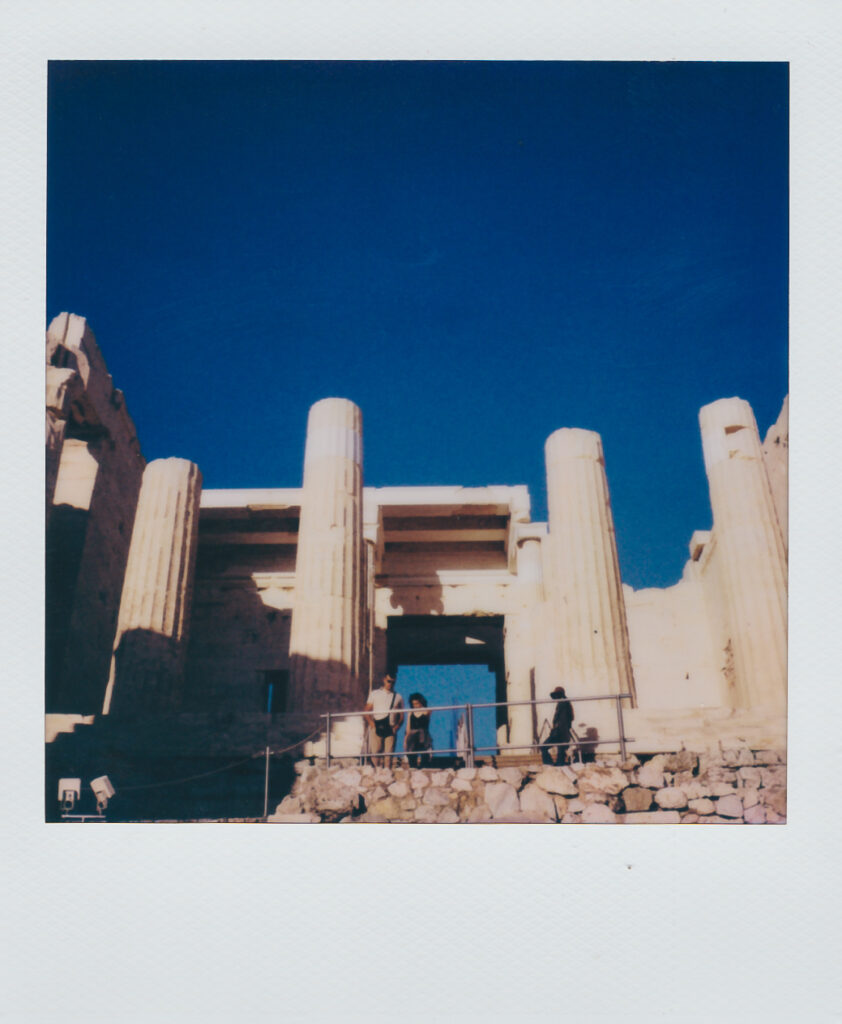
Of course, you will see the Parthenon. The Parthenon is probably the most legendary monument of ancient Greece. It is a temple dedicated to the goddess Athena, the patron of ancient Athens. Apart from being the most important building of Classical Greece, the Parthenon is also assumed to be the finest example of the Doric order. Parthenon’s construction began in 447 BC and finished in 438 BC. However, the decoration finished around 432 BC.

While climbing to the Acropolis of Athens on a warm day can be challenging, the experience is rewarding. The Acropolis lies 150 meters (490 feet) above sea level. According to historians, during the Bronze Age, a Mycenaean megaron was also standing on top of the rock. However, there’s almost no evidence of it apart from a limestone column base.
Here, you can see one more polaroid from the Parthenon, this time from the side.

And here, you can also see detail from some sculpted columns. I wanted mainly to see how visible the details will look on a polaroid photo. Behind them, you can also see the city of Athens.
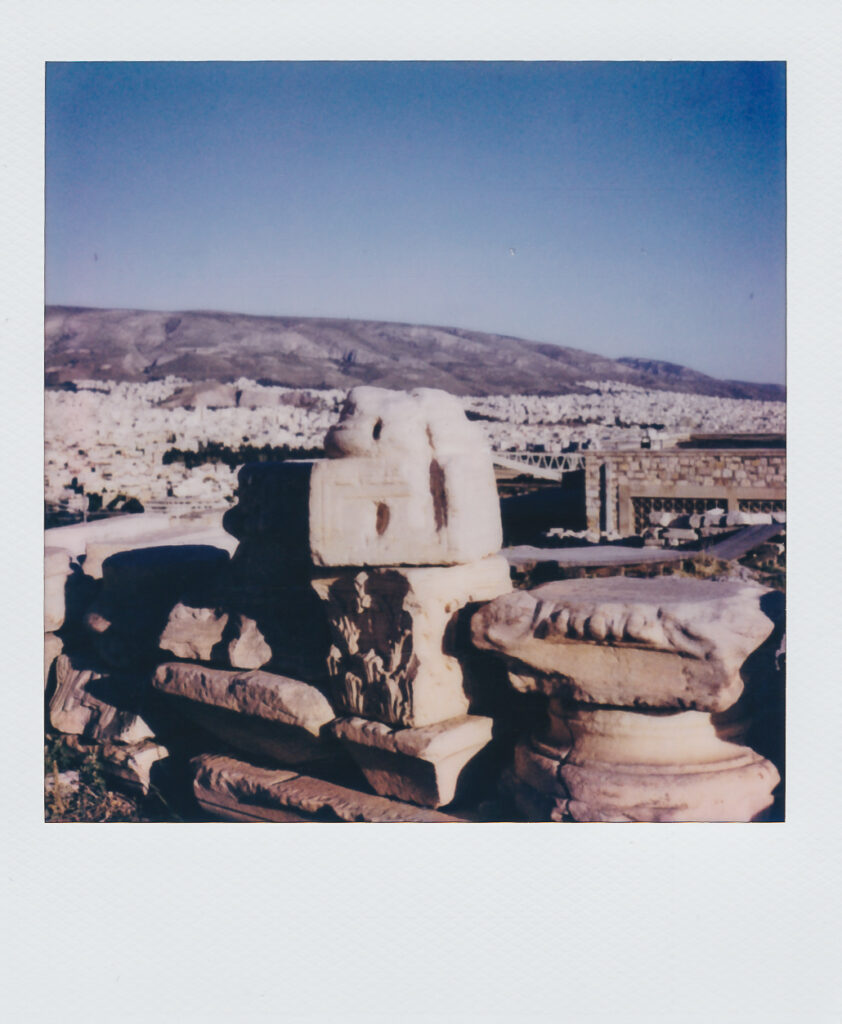
Exactly opposite the Parthenon, you can see the Erectheum or Erectheion. The Erectheion is a temple on the northern side of the hill dedicated to both Athena and Poseidon. The sculptor of the structure was Phidias, whom Pericles also employed to build the Parthenon. The construction of the Erectheion took place between 421 and 406 BC. Once again, the material was marble from Mount Penteli.
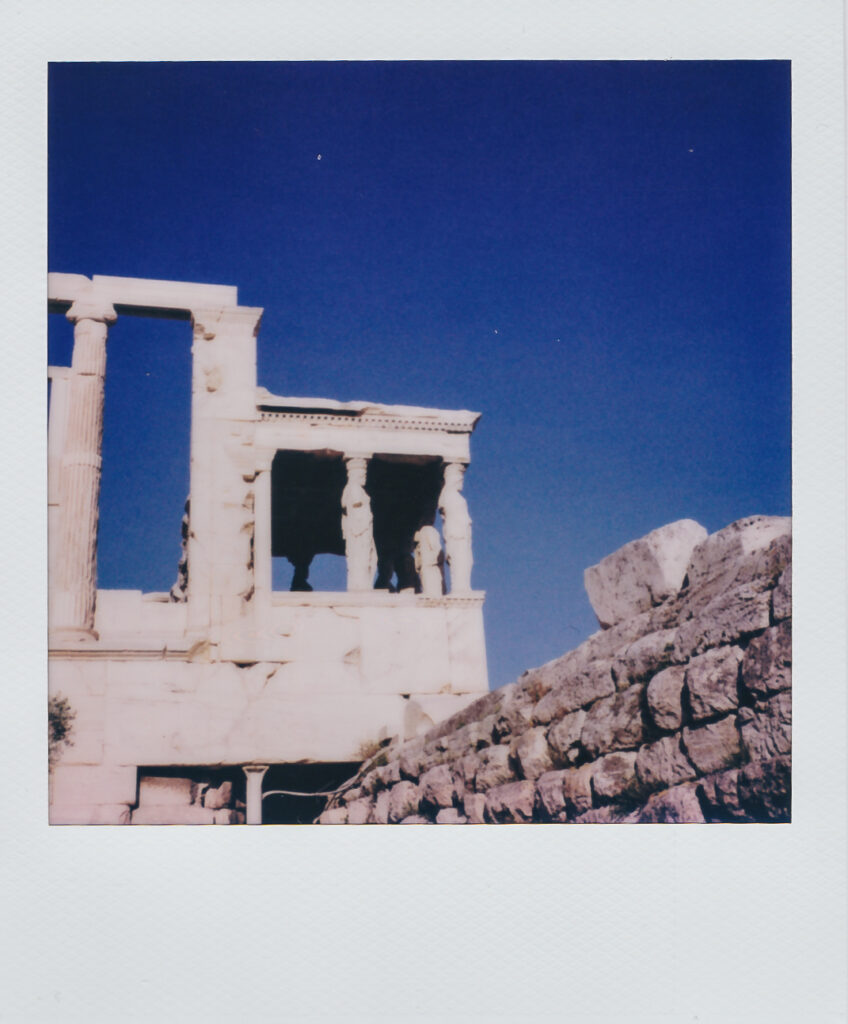
I wrote earlier about the spectacular views that one can enjoy from the top of the Acropolis, and here’s a Polaroid to prove it. What you actually see here is the view towards Lycabettus Hill and the city of Athens surrounding it. In my opinion, the SX-70 handled the photo really well, given that the light was very intense and the distance was too big.
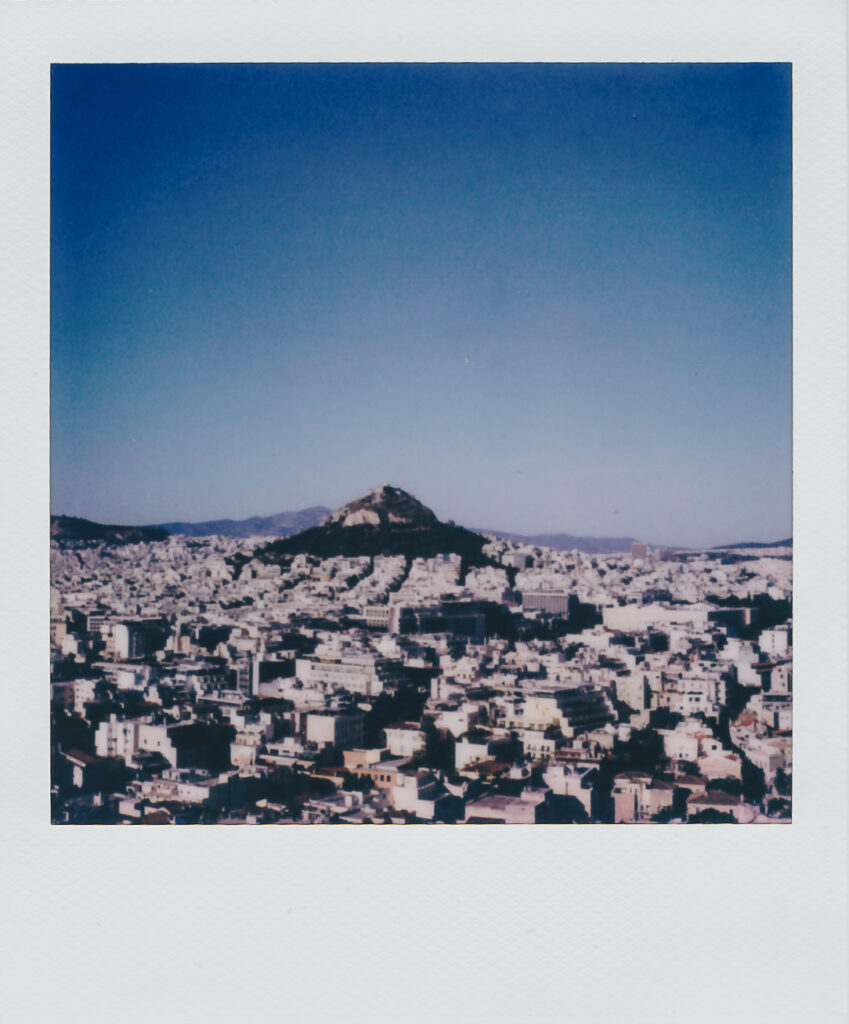
On one side of the Acropolis, there’s also a viewpoint and a Greek flag. It’s a prime spot for visitors, and apart from enjoying the view, people love taking loads of photos at the spot. Here’s what the view looks like from some distance -you’ll have the Parthenon behind you.
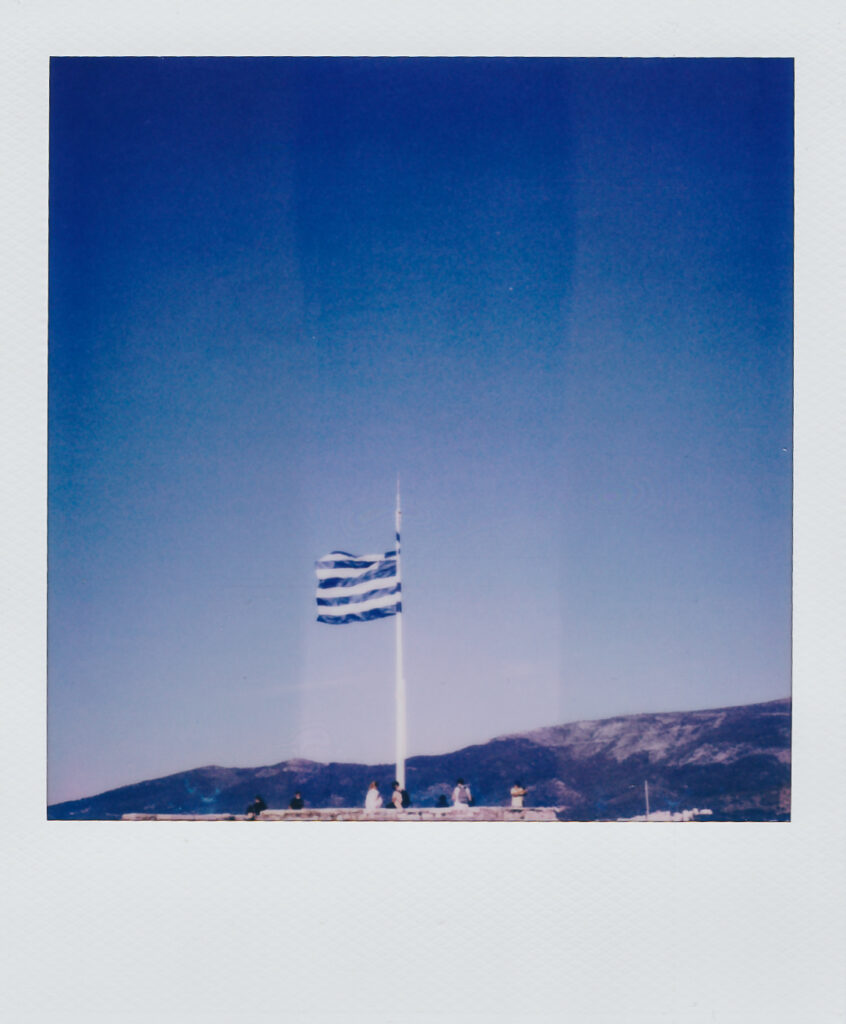
The day I decided to visit the Acropolis of Athens for some polaroids with the SX-70, my friend Ilias also joined me. We walked for hours around the area, working on a project. Shortly before leaving the Acropolis behind, I thought of taking a portrait of Ilias. After all, that’s what the SX-70 is made for: portraits. Ilias stood in front of the Parthenon, and here’s his SX-70 portrait.
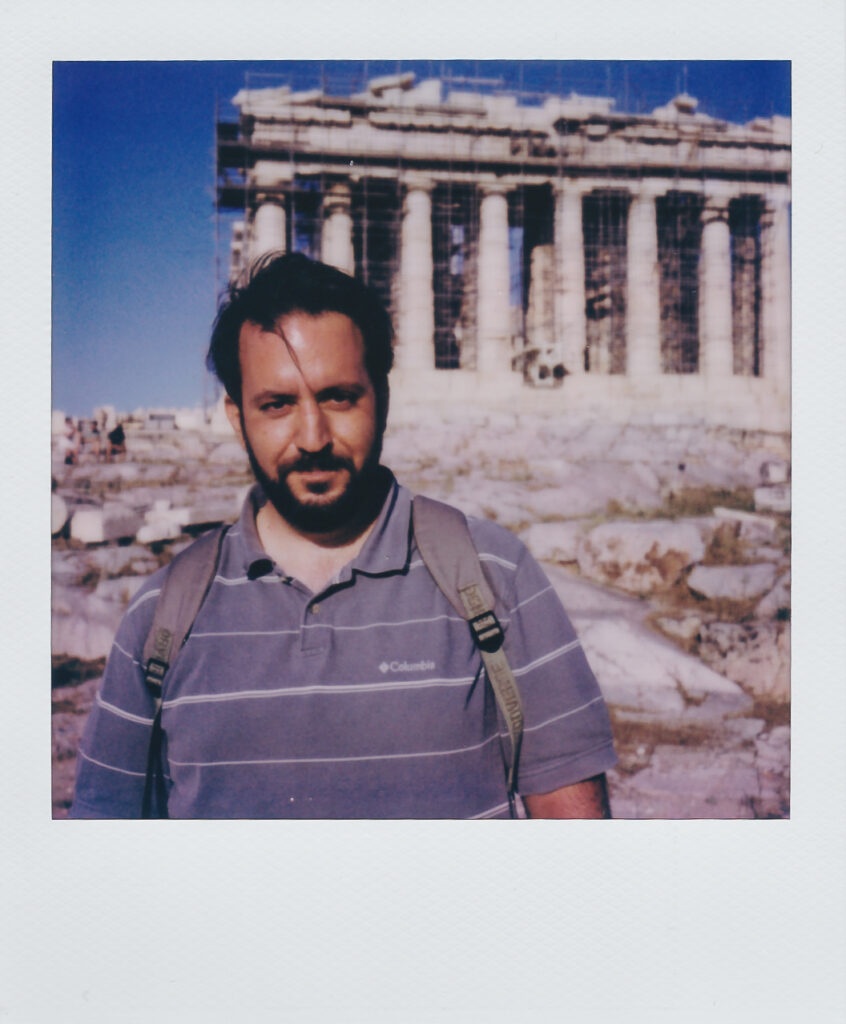
On the way down, we also stopped at the Tower of the Winds. The Tower of the Winds (a.k.a. the Horologion of Andronikos Kyrrhestes) is an octagonal clocktower in the Roman Agora in Athens made -surprise surprise- by Pentelic Marble. That’s actually a timepiece, and it’s considered the world’s first meteorological station. Greeks also refer to it as Aerides (Greek: Αέρηδες), which stands for Winds. The Tower of Winds features various pieces, including sundials, a water clock, and a wind vane.
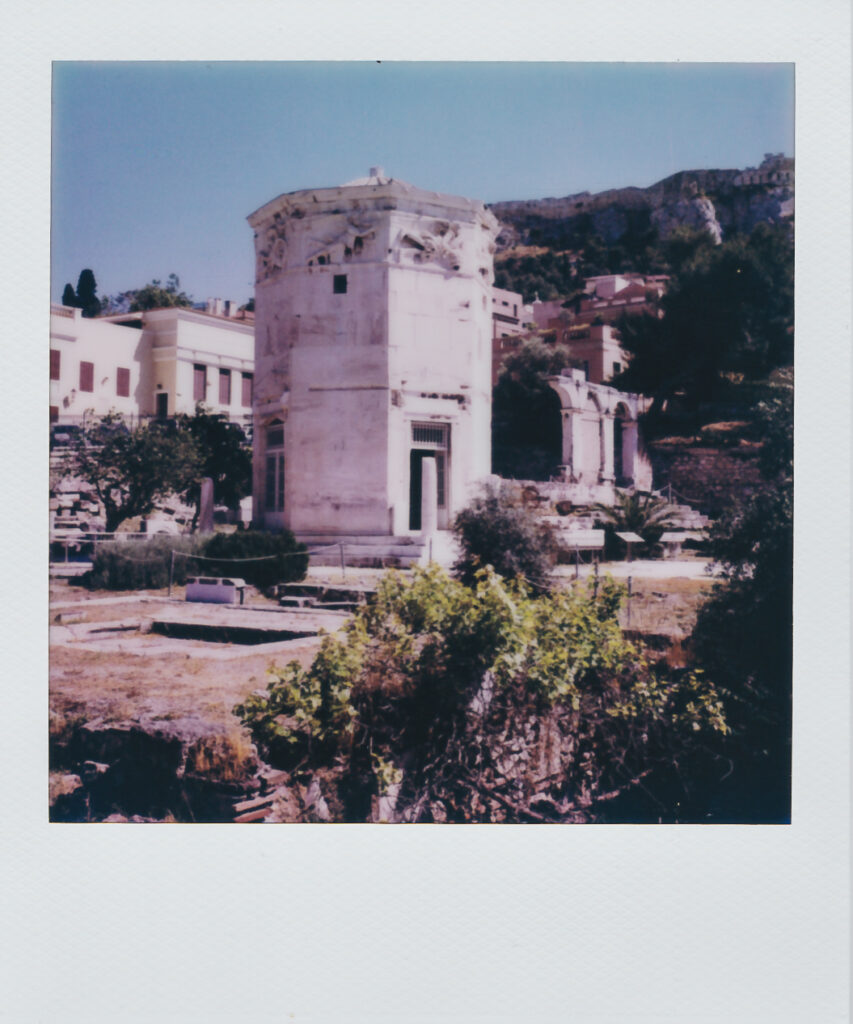
And then, shortly before sunset, we decided to return. A day at the Acropolis of Athens was now behind us, and on the highway, nothing reminded us the Greek antiquity anymore. I took one last polaroid. The setting is definitely more urban.

The settings I used for this series with the Polaroid SX-70
I always add a couple of lines about the settings I use. The Polaroid SX-70 is an almost fifty-year-old camera, and it sometimes has a mind of its own. For this installment of my Polaroid Diaries, I kept the exposure wheel straight in the middle. While I thought of either underexposing or overexposing depending on the light source, I decided to keep it in the middle. By doing so, I thought that I’d have nice shadows and well-balanced highlights.
However, this also meant that I would have to make a compromise: accept vignetting. It’s not easy to handle the bright blue sky on sunny days (exactly like in Folegandros), let alone if you shoot in the afternoon. I must admit, though, that I liked the polaroids I shot, even though the vignetting is intense at times.
And that’s it with another edition of my Polaroid Diaries and the polaroids from my day in the Acropolis of Athens. Overall, I’m pleased with the performance of the SX-70. Stay tuned for more polaroids, and feel free to subscribe to the mailing list below for polaroid tips and more diaries.
*You can buy the newest (and freshest) films and Polaroid cameras directly at Polaroid’s official website.
More Polaroids: The full Polaroid diaries, My SX-70 review, My OneStep+ review & My Polaroid GO review
Get my Polaroid Camera on Amazon | Buy the film on Amazon
Pin it for later

Sharing is caring. Share the Polaroid Diaries: The Acropolis of Athens with your friends.
Last Updated on April 15, 2024 by George Pavlopoulos


George, these are some of the best polaroid shots I have seen from you. I’m curious about the SX-70. I saw one going for $300 (190 Euro) in Australia, but it seemed to sell fast. I have also seen them going for as high as $550 (350 Euro) in shops. It seems to go for about $350 (220 Euro) on average.
What do you would think a fair price to pay for an SX-70 would be? They don’t make them anymore so how do you know if it is any good when buying second-hand. Many people in their ads say they don’t know if it works because their granddad owned it or something like that. It seems like a big risk to buy one. Where did you get yours from?
Hey John!
Thanks a lot! Indeed, these are among the best polaroids I have shot so far. The SX-70 is an amazing tool. It’s so much sharper than any other Polaroid camera out there. The lens is fantastic, it handles the colors extremely well, and it also gives you creative opportunities. It’s the most DSLR-esque Polaroid camera I know.
I plan to review it soon, but indeed it’s an old camera, and sometimes it has a mind of its own. Last week I shot some great polaroids in the Peloponnese -I plan to present them soon. The more I use the camera, the happier I am. And I finally start to understand how it works. You have to kill some film before you can make the most out of it, I guess.
To your question, I think on eBay, you can find loads of SX-70 for anything between $30 and $500. It all depends on the camera’s condition if the leather is worn out, if there are mechanical failures, etc. All that said, when you buy second-hand the SX-70, you can never be 100% sure that it works. The safest option (and the one I also went for) is to buy directly from Polaroid. The thing is that the guys in Polaroid find old SX-70 cameras, and they fully refurbish them. And they do offer a one-year guarantee. The first one I got from them had a mechanical issue that appeared after shooting the second film. They replaced it without any questions, and the one I got afterward is actually the one I use.
Of course, buying directly from Polaroid comes at a price. I think it’s closer to the $550 that you mentioned above -I linked above to the SX-70, and sometimes the prices change. I think that if you want to have an SX-70 that works like a charm and you don’t want to have one just for displaying it on the shelf, buying from them is the safest bet. It costs way more, yes, but at least if something goes wrong, you can always have it replaced.
Are you interested in getting into polaroid photography? If so, the SX-70 is definitely the most advanced camera you’ll find out there, John. You focus manually, and that’s a big plus. However, if you are unsure, you can also start with one of the beginner models (like the OneStep+ or even the Go). Yes, the images might not look that good, but they are definitely cheaper.